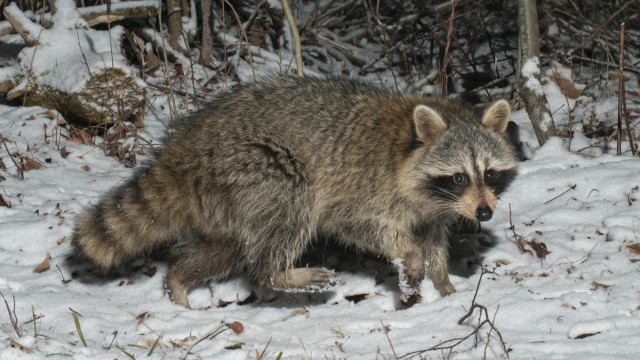Raccoons are quite resourceful at finding food and shelter. Raccoons in winter are very successful in locating den sites that have a consistent temperature and are attached to reliable food sources. We, humans, refer to those den sites as houses.

As winter arrives, raccoons have two primary goals. They want to find someplace warm to hold up and to eat as much as possible. You see, raccoons do not hibernate. Instead, they enter a state called torpor, where their body temperatures and metabolic rate are lowered. This allows them to sustain their body’s resources for a longer period—what we know as winter.
While in torpor, raccoons will sleep for long periods—from weeks to a month. However, unlike full hibernation, raccoons in torpor wake up and are active with greater regularity. This means that raccoons in winter are no less a nuisance to homeowners.
Raccoons will be able to sleep for longer periods in colder climates. They grow a thicker winter coat and increase the amount of stored fat in preparation for the colder temperatures. This means that we here in Ohio see more raccoon activity in late fall and early winter as they are busy eating everything in reach to fatten up. This leads to more nuisance wildlife issues and more frustrated homeowners.
Increase in Raccoon Population
Here in Ohio, our cold winters last through March. But the cold months from February through March are mating season for Ohio raccoons. There will be a spike in activity during these winter months as male raccoons seek out several females for mating. During this time many people report raccoons fighting in their attic. However, the growls and hissing are not from raccoons fighting—they’re mating.
Raccoon activity can increase exponentially around your home when the female gives birth to her litter. Nine weeks after mating, female raccoons give birth to their young. This is typically a litter of three to five babies. It is not uncommon for female raccoons to make a last-minute den to give birth. This is one reason raccoons find human structures so attractive in winter.
By six weeks of age, baby raccoons begin to move around the den site. If this is your attic, you will know you have a clan of raccoons by the sheer volume of constant noise. By their twelfth week, baby raccoons begin to venture out of the nest with the mother to forage. This is when you will begin to see a larger number of raccoons in your area. Of course, winter will be over at this point and the frustration of having raccoons in Spring will begin!
Raccoons are just one of the many species of Ohio wildlife that can become a nuisance in winter. But if we take the time to learn more about these animals, we’ll also learn more about preventing them from becoming a nuisance. This is safer and healthier for both them, and us.





